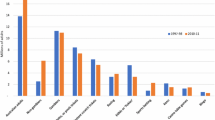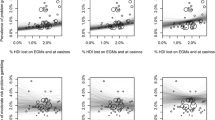Abstract
This paper investigates consumer perspectives of implemented and proposed gambling harm minimisation measures taken from a geographically stratified survey of adult residents in Tasmania, Australia. Electronic gaming machine (EGM) gamblers were asked whether current and proposed EGM harm minimisation measures impacted on their actual or anticipated gambling expenditure and enjoyment. Participants were analysed based on their endorsement of Problem Gambling Severity Index criteria (scores 0–27), and categorised as non-problem gamblers (score 0), low-risk gamblers (scores 1–2), and moderate/problem gamblers (scores 3+). Specifically, we wanted to identify harm minimisation policies that resulted in the lowest decreases in enjoyment for non-problem gamblers and the highest decreases in expenditure for moderate/problem gamblers. Regarding current policies, the lowest decrease in enjoyment for non-problem gamblers was the ban on Automatic Teller Machines (ATMs) in EGM venues (0.2 %) while the highest decrease in expenditure for moderate/problem gamblers was the reduction in maximum lines (46.9 %). For the proposed measures, the lowest decrease in enjoyment for non-problem gamblers was visible clocks (1.2 %) while the highest decrease in expenditure for moderate/problem gamblers was reducing cash withdrawals (36.3 %). These results suggest universal EGM harm minimisation measures can differentially target non-problem and moderate/problem gamblers.
Similar content being viewed by others
Notes
As there are a number of nuances regarding how these regulations are implemented across gambling mediums and activities we direct interested readers to the Tasmanian Liquor and Gaming Commission for a detailed analysis of these measures.
As respondents were free to answer questions this resulted in large variations in the total number of responses across questions.
References
ACNielson. (2007). Prevalence of gambling and problem gambling in NSW—a community survey, 2006. Sydney: NSW Office of Liquor, Gaming and Racing, Department of the Arts, Sport and Recreation.
Allen Consulting Group, Problem Gambling Research and Treatment Centre, and Social Research Centre. (2011). Social and economic impact study of gambling in Tasmania, Volume 2: Gambling survey, prepared for the Tasmanian Government Department of Treasury and Finance.
Banks, G. (2011). Evidence and social policy: The case of gambling. Presentation to South Australian Centre for Economic Studies, Corporate Seminar, Adelaide, 30 March 2011. Retrieved 11th June 2013 from: http://www.pc.gov.au/__data/assets/pdf_file/0004/107671/evidence-and-social-policy-gambling.pdf.
Blaszczynski, A. (2001). Harm minimisation strategies in gambling: An overview of international initiatives and interventions. Canberra: Australian Gaming Council.
Christensen, D. R., Dowling, N. A., Jackson, A. C., & Thomas, S. A. (2014). Gambling participation and problem gambling severity in a stratified random survey: Findings from the second social and economic impact study of gambling in Tasmania. Journal of Gambling Studies. doi:10.1007/s10899-014-9495-9.
Currie, S. R., Miller, N., Hodgins, D. C., & Wang, J.-L. (2009). Defining a threshold of harm from gambling for population health surveillance research. International Gambling Studies, 9, 19–38.
Davidson, T., & Rodgers, B. (2010). 2009 survey of the nature and extent of gambling, and problem gambling, in the Australian Capital Territory. Adelaide: Australian National University & Australian Capital Territory Gambling and Racing Commission.
Delfabbro, P. (2008). Australasian gambling review third edition (1992–2007). Adelaide: Independent Gambling Authority, South Australia.
Delfabbro, P. (2010). A review of Australian gambling research: Implications for interjurisdictional public policy and regulation, 2nd update version. Canberra: Gambling Research Australia.
Department of Families, Housing, Community Services and Indigenous Affairs. (2012). A national snapshot of harm minimisation strategies, Canberra.
Dowling, N. A., Lorains, F. K., & Jackson, A. C. (2014). Are the profiles of past-year internet gamblers generalizable to regular internet gamblers? Computers in Human Behavior, 43, 118–128.
Ferris, J., & Wynne, H. (2001). The Canadian Problem Gambling Index: Final report. Ottawa, ON: Canadian Centre on Substance Abuse.
Francis, K. L., Dowling, N. A., Jackson, A. C., Christensen, D. R., & Wardle, H. (2014). Gambling motives: Validation of the reasons for gambling Questionnaire in an Australian population survey. Journal of Gambling Studies. doi:10.1007/s10899-014-9458-1.
Gainsbury, S. M., Blankers, M., Wilkinson, C., Schelleman-Offermans, K., & Cousijn, J. (2014). Recommendations for international gambling harm-minimisation guidelines: Comparison with effective public policy. Journal of Gambling Studies. doi:10.1007/s10899-013-9389-2.
Gainsbury, S., & Blaszczynski, A. (2012). Harm minimisation: Gambling. In R. Pates & D. Riley (Eds.), Harm reduction in substance use and high-risk behaviour (pp. 263–278). Chichester, West Sussex: Wiley-Blackwell.
Gainsbury, S., Russell, A., Hing, N., Wood, R., Lubman, D., & Blaszczynski, A. (2015). How the internet is changing gambling: Findings from an Australian prevalence survey. Journal of Gambling Studies, 31, 1–15.
Gotestam, K. G., & Johansson, A. (2003). Characteristics of gambling and problematic gambling in the Norwegian context: A DSM-IV-based telephone interview study. Addictive Behaviors, 28(1), 189–197.
Griffiths, M. D. (2010). Problem gambling in Europe: What do we know? Casino and Gaming International, 6(2), 81–84.
Jackson, A. C., Thomas, S. A., Chen, Z., Vasiliadis, S., & Tirachaimongkol, T. (2009). Gambling and harm minimisation in Australia: An overview of the evidence base. Paper prepared for the Australasian Gaming Council. Melbourne: Problem Gambling Research and Treatment Centre.
Jackson, A. C., Wynne, H., Dowling, N. A., Tomnay, J., & Thomas, S. A. (2010). Using the CPGI to determine problem gambling prevalence in Australia: Measurement issues. International Journal of Mental Health and Addiction, 8(4), 570–582.
Korn, D. A., & Shaffer, H. J. (1999). Gambling and the health of the public: Adopting a public health perspective. Journal of Gambling Studies, 15(4), 289–365. doi:10.1023/a:1023005115932.
McMillen, J., & Marshall, D. (2004). 2003 Victorian longitudinal community attitudes survey. Canberra: The Centre for Gambling Research, Australian National University.
Morasco, B. J., Pietrzak, R. H., Blanco, C., Grant, B. F., Hasin, D., & Petry, N. M. (2006). Health problems and medical utilization associated with gambling disorders: Results from the national epidemiologic survey on alcohol and related conditions. Psychosomatic Medicine, 68(6), 976–984. doi:10.1097/01.psy.0000238466.76172.cd.
Neale, P., Delfabbro, P., & O’Neil, M. (2005). Problem gambling and harm: A National definition. Adelaide, SA: Gambling Research Australia.
O’Connell, M. E., Boat, T., & Warner, K. E. (Eds.). (2009). Preventing mental, emotional, and behavioural disorders among young people: Progress and possibilities. National Research Council and Institute of Medicine of the National Academies. Washington, D. C: The National Academies Press.
Parke, J., Rigbye, J., & Parke, A. (2008). Cashless and card-based technologies in gambling: A review of the literature. Birmingham: The Gambling Commission.
Productivity Commission. (2010). Gambling: Productivity commission inquiry report. Canberra: Australian Government.
Queensland Government. (2008). Queensland household gambling survey 2006–07. Brisbane: Queensland Government.
Robitaille, E., & Herjean, P. (2008). An analysis of the accessibility of video lottery terminals: The case of Montreal. International Journal of Health Geographics, 7, 2.
Schottler Consulting. (2009). A study of gambling in Victoria: Problem gambling from a public health perspective. Melbourne: Office of Gaming and Racing, Department of Justice.
Tasmanian Gaming Commission. (2010a). Responsible gambling mandatory code of practice for Tasmania. Hobart: Department of Treasury and Finance.
Tasmanian Gaming Commission. (2010b). Implementation of gambling harm minimisation measures. Australia: Tasmanian Government.
Tasmanian Gaming Commission. (2012). Implementation of gambling harm minimisation measures. Australia: Tasmanian Government.
Tasmanian Gaming Commission. (2013). Responsible gambling mandatory code of practice for Tasmania. Hobart, Australia: Tasmanian Government.
Welte, J. W., Barnes, G. M., Wieczorek, W. F., Tidwell, M.-C. O., & Hoffman, J. H. (2007). Type of gambling and availability as risk factors for problem gambling: A tobit regression analysis by age and gender. International Gambling Studies, 7(2), 183–198.
Welte, J. W., Barnes, G. M., Wieczorek, W. F., Tidwell, M.-C. O., & Parker, J. C. (2002). Gambling participation in the U.S.: Results from a national survey. Journal of Gambling Studies, 18(4), 313–337.
Williams, R. J., West, B. L., & Simpson, R. I. (2007). Prevention of problem gambling: A comprehensive review of the evidence. Report prepared for the Ontario Problem Gambling Research Centre, Ontario, Toronto: OPGRC.
Young, M., Duhou, I., Barnes, T., Creed, E., Morris, M., Stevens, M., et al. (2006). Northern territory gambling prevalence survey 2005. Darwin: School for Social and Policy Research, Charles Darwin University.
Young, M., Tyler, B., & Lee, W. (2007). Destination-style gambling. Review of the literature concerning the reduction of problem gambling and related social harm through the consolidation of gambling supply structures. Melbourne: Department of Justice, Victorian Government.
Author information
Authors and Affiliations
Corresponding author
Additional information
Alun C. Jackson, Darren R. Christensen: Equal First Authorship.
Rights and permissions
About this article
Cite this article
Jackson, A.C., Christensen, D.R., Francis, K.L. et al. Consumer Perspectives on Gambling Harm Minimisation Measures in an Australian Jurisdiction. J Gambl Stud 32, 801–822 (2016). https://doi.org/10.1007/s10899-015-9568-4
Published:
Issue Date:
DOI: https://doi.org/10.1007/s10899-015-9568-4




